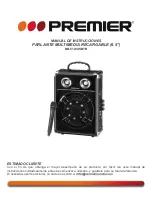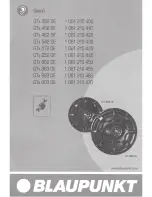
GOLDBERG AND MÄKIVIRTA
OPTIMISED EQUALISATION COMPARISON
AES 116TH CONVENTION, BERLIN, GERMANY, 2004 MAY 8-11
2
tively measurable target known to relate to the percep-
tion of sound as being free from coloration, such as a
flat third-octave smoothed magnitude response.
The purpose of this paper is to investigate how the
standard room response controls available in active
loudspeakers [11] compare to the industry standard
method for sound system equalisation, i.e. a 31-band
third-octave graphic equaliser. It is obvious that a
graphical equaliser has many more adjustment degrees
of freedom compared to the standard room response
equalisers employed in active loudspeakers – there are
31 gains with fixed Q’s and centre frequencies in a
graphical equaliser compared to some three to five
separate settings with two to seven discrete values in
the room response equaliser. This would appear to
suggest that a graphical equaliser should achieve a su-
perior outcome if set properly. However, the centre
frequencies, and fixed Q, of a graphical equaliser are
not designed to cope with typical room response prob-
lems and it is rather naïve to simply suggest that the
higher degrees of freedom alone could be taken as an
indication of how much better or worse one method is
compared to another.
This paper presents a performance comparison of a
room response control set available in active loud-
speakers and a standard 31-band graphic equaliser.
Optimisation algorithms are used to set both equalis-
ers to achieve the best possible fit to the desired flat
in-room magnitude response. To make possible this
comparison, an optimisation algorithm was developed
to set the gains of a 31-band graphical equaliser. This
method is described. The performance of the equalisa-
tions and optimisation algorithms is investigated by
studying the statistical properties of 67 in-situ magni-
tude responses before and after equalisation.
2. IN-SITU
EQUALISATION
The room response controls were previously described
in [12-14]. A constant-Q type 31-band DSP graphic
equaliser [15] was constructed using bi-quadratic
transfer functions of the form,
2
2
1
1
2
2
1
1
0
1
)
(
−
−
−
−
+
+
+
+
=
z
a
z
a
z
b
z
b
b
z
H
(1)
where the scaling of the transfer function is given by
the coefficients,
(
)
20
0
0
10
2
2
sin
1
G
S
A
QA
/f
f
a
=
+
=
π
(2)
with the centre frequency
f
0
, sampling frequency
f
S
,
gain of the resonance
A
, calculated from the dB-gain
value
G
, and the resonance goodness
Q
. The filter co-
efficients are then defined as,
(
)
(
)
(
)
(
)
(
)
0
0
2
0
0
1
0
0
2
0
0
1
0
0
0
2
2
sin
1
2
cos
2
2
2
sin
1
2
cos
2
2
2
sin
1
a
QA
/f
f
a
a
/f
f
a
a
Q
/f
f
A
b
a
/f
f
b
a
Q
/f
f
A
b
S
S
S
S
S
⎟⎟
⎠
⎞
⎜⎜
⎝
⎛
−
=
−
=
⎟⎟
⎠
⎞
⎜⎜
⎝
⎛
−
=
−
=
⎟⎟
⎠
⎞
⎜⎜
⎝
⎛
+
=
π
π
π
π
π
(3)
where
f
0
is set to the centre frequency of each of the
31 filter bands according to ISO and IEC [16,17].
These standards do not explicitly define the
Q
, instead
a magnitude response tolerance is given to allow for
design differences between manufacturers. For this
study
Q
= 4.33,
33
.
4
10
10
10
05
.
0
05
.
0
0
=
−
=
=
−
+
n
n
n
B
f
Q
(4)
where
n
is a value that gives the third-octave band
centre frequency, e.g.
n
= 3 for 1 kHz, and
B
is the
bandwidth of the third-octave resonance.
As is common practice in most commercially avail-
able hardware, the gain
G
is bound between 0 and –12
dB. Note that contrary to most hardware solutions, no
positive gain is allowed and there is no overall make-
up gain to compensate for broadband attenuation. En-
gineers commonly use this technique to avoid over-
loading the loudspeaker.
3. OPTIMISATION OF THE EQUALISATION
3.1. Room Response Control Optimiser
The five-stage algorithm previously described in
[12,14] to find optimal settings for room response
control exploits the heuristics of experienced system
calibration engineers, thereby achieving computa-
tional efficiency by avoiding unrealistic filter setting
combinations. A fast optimisation time is also
achieved by breaking down the process into stages.



































